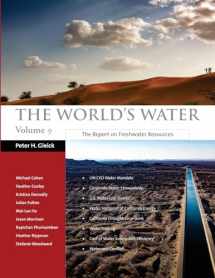
The World's Water Volume 9: The Report on Freshwater Resources
Book details
Summary
Description
The World’s Water: The Report on Freshwater Resources (from the Pacific Institute) is the pre-eminent publication regularly addressing global freshwater challenges and solutions. The first volume was published in 1998 and the current volume – the ninth – continues the tradition of tackling timely, critical freshwater problems in a fresh, easy-to-read style. Information on the previous volumes and important water data can be found online at www.worldwater.org. When the first volume of The World’s Water was published in 1998, the United Nations’ Millennium Development Goals (MDGs) for 2015 had not even been established. The concepts of water “footprints,” “virtual water,” “corporate water stewardship,” “peak water,” and other now-central topics had not yet been put forward or were mostly unknown. Yet today, the MDGs have been replaced with a new set of comprehensive environmental and social targets, the Sustainable Development Goals (SDGs) for 2030. A wide variety of research, academic, advocacy, and policy groups are addressing water problems in new and innovative ways. And the demand for good water analysis is greater than ever. This new volume continues to offer insights into critical global water problems, overviews of data and analysis around water use and management, and case studies of some of the greatest water challenges around the world. The chapters in the current volume include the issue of corporate water stewardship, the human right to water and sanitation, water-use trends in the United States, an assessment of the water footprint of California energy, the consequences of the severe five-year California drought, a review of water markets and economic strategies for water management, and a summary of the cost of alternative water supply and demand strategies. The current volume also includes the regular update on the Pacific Institute’s unique Water Conflict Chronology, with historical examples of conflicts related to water going back to 2500 BC and new entries through early 2017; a summary of the 2017 Pontifical Academy of Sciences Vatican meeting on the human right to water; and a review of critical issues around public access to water through drinking fountains. The World’s Water has always been about more than just bad news. There is plenty of good news and there are many innovative efforts underway to identify and implement sustainable water solutions. The latest volume continues the tradition of bringing these solutions to students, the public, policy makers, and scientists working to understand the world of water.


We would LOVE it if you could help us and other readers by reviewing the book
Book review



